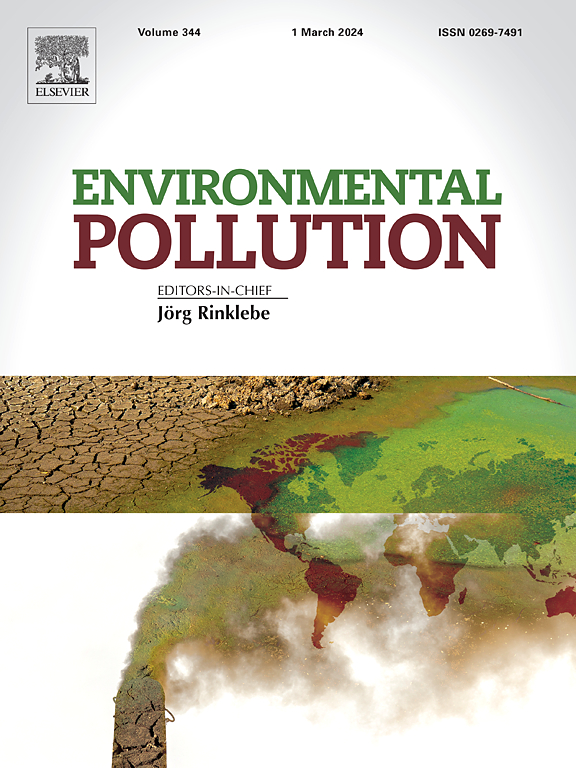Adsorption of benzophenone-3 and octocrylene UV filters on polyethylene: analysis by HPLC-MS/MS and voltammetry with screen-printed electrodes
IF 7.6
2区 环境科学与生态学
Q1 ENVIRONMENTAL SCIENCES
引用次数: 0
Abstract
Microplastics (MPs) are persistent pollutants that can adsorb contaminants, facilitating their accumulation in aquatic ecosystems. The presence of UV filters (UVFs) such as benzophenone-3 (BP3) and octocrylene (OC), exacerbates this issue, particularly in coastal areas. This study presents an innovative dual-method approach combining high-performance liquid chromatography tandem mass spectrometry (HPLC-MS/MS) and differential pulse adsorptive stripping voltammetry (DPAdSV) to assess the adsorption of UVFs on polyethylene (PE), a widely found polymer in aquatic environments. Adsorption kinetics were analysed using pseudo-first-order (PFOM) and pseudo-second-order (PSOM) models, revealing a higher equilibrium sorption capacity for OC due to its stronger hydrophobic interactions with PE. A central composite design (CCD) was employed to enhance resources efficiency in experimentation and controlled experiments exposed the materials to both pure fresh water and synthetic seawater. The results indicate a higher adsorption affinity of OC on PE than BP3, attributed to its high octanol-water partition coefficient (log Kow 6.88) and stronger hydrophobic interactions. Exposure time was the most influential variable across both media, while pH and temperature had a significant effect on BP3 adsorption in synthetic seawater. Hydrophobic partitioning, aided by van der Waals forces, was identified as the dominant interaction mechanism for both UVFs, with π–π and electrostatic interactions playing minimal roles due to the nature of the polymer. The study provides new insights into how polymer–pollutant interactions vary across environmental conditions and offers a novel voltammetric alternative for in-situ UVFs monitoring.

聚乙烯对二苯甲酮-3和八烯紫外滤光片的吸附:用高效液相色谱-质谱联用和丝网印刷电极伏安法分析
微塑料(MPs)是持久性污染物,可以吸附污染物,促进其在水生生态系统中的积累。紫外线过滤器(UVFs)如二苯甲酮-3 (BP3)和八烯(OC)的存在加剧了这一问题,特别是在沿海地区。本研究提出了一种创新的双方法,结合高效液相色谱串联质谱(HPLC-MS/MS)和差分脉冲吸附溶出伏安法(DPAdSV)来评估UVFs在水生环境中广泛存在的聚合物聚乙烯(PE)上的吸附。采用伪一阶(PFOM)和伪二阶(PSOM)模型分析了OC的吸附动力学,结果表明OC与PE的疏水相互作用更强,具有更高的平衡吸附能力。在实验和对照实验中,采用中心复合设计(CCD)提高资源效率,将材料暴露于纯淡水和合成海水中。结果表明,OC对PE的吸附亲和力高于BP3,这主要是由于其辛醇-水分配系数高(log k_6.88)和疏水相互作用强。暴露时间是两种介质中影响最大的变量,而pH和温度对合成海水中BP3的吸附有显著影响。在范德华力的帮助下,疏水分配被确定为两种UVFs的主要相互作用机制,由于聚合物的性质,π -π和静电相互作用的作用很小。该研究为聚合物-污染物相互作用在不同环境条件下的变化提供了新的见解,并为原位UVFs监测提供了一种新的伏安替代方案。
本文章由计算机程序翻译,如有差异,请以英文原文为准。
求助全文
约1分钟内获得全文
求助全文
来源期刊

Environmental Pollution
环境科学-环境科学
CiteScore
16.00
自引率
6.70%
发文量
2082
审稿时长
2.9 months
期刊介绍:
Environmental Pollution is an international peer-reviewed journal that publishes high-quality research papers and review articles covering all aspects of environmental pollution and its impacts on ecosystems and human health.
Subject areas include, but are not limited to:
• Sources and occurrences of pollutants that are clearly defined and measured in environmental compartments, food and food-related items, and human bodies;
• Interlinks between contaminant exposure and biological, ecological, and human health effects, including those of climate change;
• Contaminants of emerging concerns (including but not limited to antibiotic resistant microorganisms or genes, microplastics/nanoplastics, electronic wastes, light, and noise) and/or their biological, ecological, or human health effects;
• Laboratory and field studies on the remediation/mitigation of environmental pollution via new techniques and with clear links to biological, ecological, or human health effects;
• Modeling of pollution processes, patterns, or trends that is of clear environmental and/or human health interest;
• New techniques that measure and examine environmental occurrences, transport, behavior, and effects of pollutants within the environment or the laboratory, provided that they can be clearly used to address problems within regional or global environmental compartments.
 求助内容:
求助内容: 应助结果提醒方式:
应助结果提醒方式:


